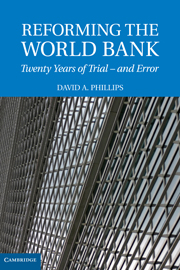Book contents
- Frontmatter
- Contents
- Preface: The Search for Effectiveness in the World's Premier Development Institution
- REFORMING THE WORLD BANK
- PART I ORIGINS AND EVOLUTION
- PART II THE SEARCH FOR EFFECTIVENESS
- 3 Fifty Years of Bank Reforms
- 4 The 1990s – Re-Engineering the Organization
- 5 Changing Culture and Changing People
- 6 Reforming the Bank's Assistance Product
- 7 Changing the Quality of Development Assistance
- 8 Financing the Reorganization
- 9 Why Did the Reforms Fail?
- PART III TOWARDS REAL REFORM: THE GOVERNANCE AGENDA
- Index
9 - Why Did the Reforms Fail?
Published online by Cambridge University Press: 25 January 2011
- Frontmatter
- Contents
- Preface: The Search for Effectiveness in the World's Premier Development Institution
- REFORMING THE WORLD BANK
- PART I ORIGINS AND EVOLUTION
- PART II THE SEARCH FOR EFFECTIVENESS
- 3 Fifty Years of Bank Reforms
- 4 The 1990s – Re-Engineering the Organization
- 5 Changing Culture and Changing People
- 6 Reforming the Bank's Assistance Product
- 7 Changing the Quality of Development Assistance
- 8 Financing the Reorganization
- 9 Why Did the Reforms Fail?
- PART III TOWARDS REAL REFORM: THE GOVERNANCE AGENDA
- Index
Summary
RECENT THOUGHTS ON REORGANIZATION
In the 1980s and 1990s, corporate re-engineering was a significant factor in corporate America, but many of its advocates revised their ideas. Michael Hammer, perhaps the tsar of all organizational reformers, in the second edition of Reengineering the Corporation wrote: ‘[P]erhaps predictably, reengineering quickly became a bandwagon that everyone tried to jump on; but, problematically not everyone knew precisely what it was he or she was getting involved in’. ‘Give me re-engineering and give it to me fast’ was the command from many uninformed chief executives. This was a situation ripe for disaster. Re-engineering came to be viewed as an easy panacea that the CEO can simply delegate. John Kotter said, later on: ‘[T]he perception that large organizations are filled with recalcitrant middle managers who resist all change is not only unfair but untrue’.
Second thoughts were already abroad as the Bank launched its own re-engineering revolution, but public organizations and their overseers tend to follow rather than lead with regard to ideas about corporate efficiency, effectiveness, and change, and the Bank was a follower.
WHAT WENT WRONG?
There were serious problems in nearly all the dimensions of the Bank's reorganization program. The re-engineering of the organization was semi-chaotic, poorly designed and managed, and had to be partially reversed, largely failing to meet its objectives of increasing the efficiency of skill usage and only partly increasing focus at the country level.
- Type
- Chapter
- Information
- Reforming the World BankTwenty Years of Trial - and Error, pp. 210 - 224Publisher: Cambridge University PressPrint publication year: 2009

